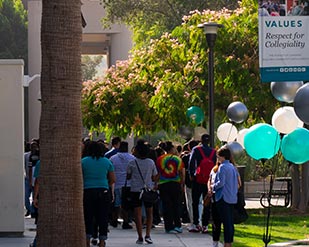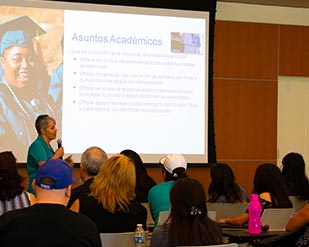Program Review
Accountability Matters
Program Review is a regular process of institutional assessment and analysis of MVC services and programs. Program Review acts as a collaborative goal-setting process, assists MVC in allocating resources and effort, and identifying and documenting deliverable outcomes.
The yearly deadline for annual or comprehensive program review reports is October 1.
About Program Review and Resource Requests
Prioritizations
Program Review Areas
Planning and Development program review is designed to assess outcomes, set unit and department goals, and request resources to better facilitate the College in reaching its institutional goals.
Student Services Program Review is designed to assess performance and help improve student services and support programs.
Helpful Resources
Prioritizing Requests
The process for prioritizing annual program review resource requests is conducted in alignment with Moreno Valley College institutional plans.
The resource request criteria include safety/health/legal requirements, and the Strategic Enrollment Plan, which includes a crosswalk with the Guided Pathways framework, Integrated Strategic Plan, Education Master Plan, Student Equity Plan and Vision for Success. Additional considerations include the impact for students, and the duration of the impact.
Assess each request for any safety, health, legal, or compliance issues that are involved. Requests that address critical safety, health, legal, or compliance concerns should be prioritized high.
Assess each request for alignment with Strategic Enrollment Plan, which includes a crosswalk with college priorities and plans; Guided Pathways, Integrated Strategic Plan, Education Master Plan, Student Equity Plan and Vision for Success. Requests that support completion of identified activities in the SEMP should receive prioritized ranking.
Assess each request for Duration of the Impact: consider the duration of the impact that each request will have, whether it is long term or short term: prioritize requests that address long-term, sustained impacts on the institution, such as a 20-year equipment/facility investment; prioritize one-time events that have a significant, short-term impact if they align with other criteria. Additional metrics will consider the scale of impact (large, moderate, or small) of student.
Annual Timeline
- August 15: Areas/departments/programs are provided a summary of the prior year's highlights.
- September 1: Integrated Strategic Plan (ISP) Annual Report draft is provided to inform program review
- October 1: Program reviews are due
- November 1 - December 31: Prioritization of resource requests through division advisories
- January 1 - 31: Vice Presidents present unit priority list to Cabinet
- February 1 - March 31: Prioritized list is shared with the College and feedback is collected
- April 1 - 30: Units make purchases
- May 1 - 31: Evaluation of program reviews and resource requests
Funding Source Definitions
The General Fund is the primary operating fund of the district. It is used to account for those transactions that, in general, cover the full scope of operations of the district (instruction, administration, student services, maintenance and operations, etc.). Generally, these funds are not designated by law or a donor agency for a specific purpose. Unrestricted funds may have been designated by the Board for a specific purpose, but they are still legally regarded as unrestricted since the designation may be changed at the Board’s discretion.
Strong Workforce funds are intended to support smaller class sizes for certain career technical education (CTE) courses, relatively expensive CTE equipment costs, and regional planning and coordination.
California Community College Mathematics, Engineering, Science Achievement (MESA) help underserved and underrepresented students majoring in calculus-based STEM (Science, Technology, Engineering and Mathematics) fields who seek to transfer to a four-year institution. Funding is to be used for community college faculty, staff, business leaders, students, and four-year colleges and universities to work collaboratively to support economically and educationally disadvantaged students.
Retention and Enrollment Outreach funds are primarily to engage former community college students that may have withdrawn from college due to the impacts of COVID-19, as well as with current community college students that may be hesitant to remain in college and prospective students that may be hesitant to enroll in a community college due to COVID-19.
SFAA funds may be used for financial aid professional, technical, clerical, or temporary help (including student help) who report in a direct line to the Financial Aid Director; computer hardware or software necessary for and solely dedicated to the delivery of student financial aid; expenses associated with staff training; and for the development and production of financial aid outreach materials.
Districts may allocate their share of the total state allocation between the physical plant, instructional support, water conservation, and energy efficiency projects to meet their local needs.
Physical Plant funds provides funding to districts for non-recurring repair and maintenance of facilities and to correct and avoid health and safety hazards, maintain an environment conducive to learning, and improve long-term cost effectiveness of facility operations. These funds can be used for:
- scheduled maintenance/special repairs, including architectural barrier removal, seismic retrofit, hazardous substances;
- water conservation, including landscape/synthetic turf, building improvements, drip/low-flow irrigation system, and well meter installation; and
- support for energy efficiency.
Instructional Support funds assist districts with their ever-growing need for instructional equipment, library materials, and technology on community college campuses due to aging equipment and inadequate funding.
The allowable uses of restricted Proposition 20 lottery funds include:
- instructional materials;
- laptops and hotspots for students, teachers, and faculty as learning resources; and
- student basic needs including housing and food assistance.




